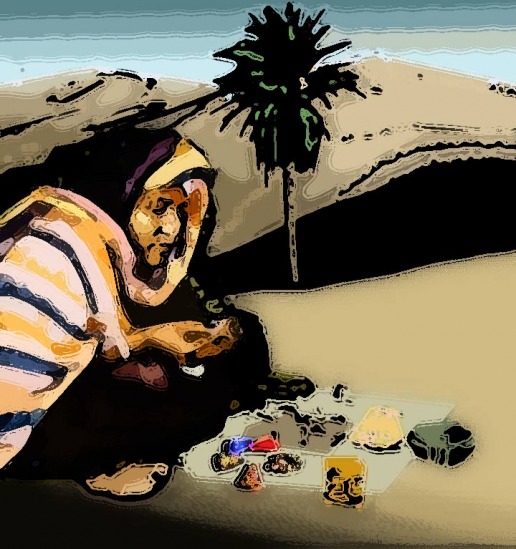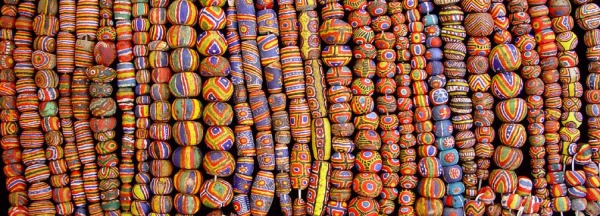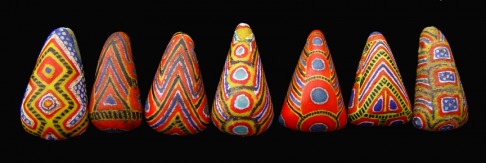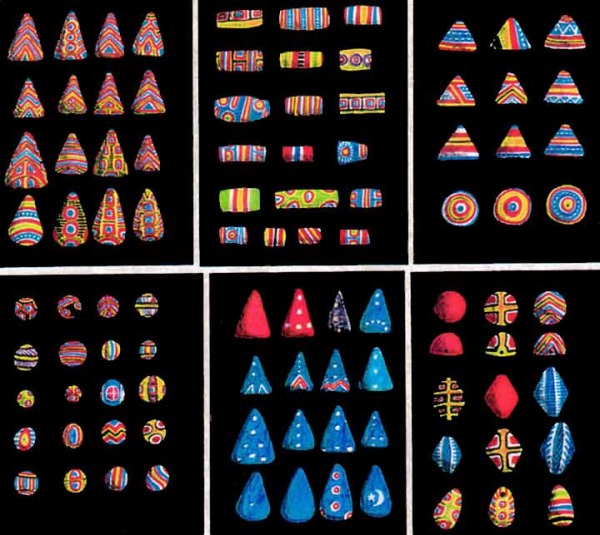MAURITANIAN WET POWDER GLASS BEADS

Using a fairly crude and simple process, with painstaking attention to detail, a Nomadic woman of the Western Sahara creates one of the world’s most beautiful beads.
The Mauritanian wet powder glass bead, or Kiffa bead, as it is commonly called, has been traced back hundreds of years. Other authorities claim it is a modern era bead dating back no more than 100 years. One thing is clear: the Kiffa bead which collectors relish is not reported as being currently produced. I do not include the “Kiffa” beads readily available in today’s market, which have been created for the tourist/souvenier trade rather the personal adornment of the Nomadic women that once made the beads themselves. Arguments have been made that these modern “versions” are the same bead only newer, a point I utterly disagree with. The original Kiffa beads copied ancient Islamic beads and possibly Venetian beads introduced into the African Trade, the modern versions copy the original Kiffa beads, and in most all cases, very poorly.
BEAUTY AND MYSTERY

The kiffa bead is by far one of the most controversial beads in modern bead history.
When were they first created, why and how???
What influenced their designs?
How can we properly date kiffa beads?
Why were they made and how were they worn? I am at the mercy of previous bead scholars and chroniclers….
The classical Wet Powder Glass Bead, known the world over as the Kiffa Bead is made by Nomadic women in the Western Sahara country of Mauritania.
These beads are meticulously made using the most primitive of tools in some of the most demanding environments on earth……different colors of glass are ground to a fine powder and kept separate from one another. Principally the colors used are white, yellow, red, blue and black, sometimes green is substituted for either the blue or black.
Based on the colors used, the opacity of the glass and other visual indicators the glass used can be most closely compared to the oval beads from Bohemia, Czechoslovakia that have been used in the African trade for well over one hundred years.
below: a Kiffa Bead study, illustrations by Thomas Stricker ca. 1986
WHAT IS A BEAD ANYWAY???
I've heard Beads referred to as, "anything with a hole, worn suspended from
the hole", as simplistic as it seems, is not all that far from the truth.
Beads have come a long way since humans first decided to wear them. One
could argue that beads arrived with conscious awareness.
Primal superstitions, early appreciation for natural beauty and utilitarian
function would have been reasons for wearing beads early in human history.
Since the earliest shell, (stone, bone, nut, seed, feather, flower, amber,
horn, antler, etc), with a hole, was suspended for the sake of use, the bead
has truly evolved into the multi facetted object it is today. Beads come in
as many types as there ARE types, they can be any size or shape, color or
texture. Glass, metal, stone, bone are all material beads can be made of,
animal, vegetable and mineral, beads have no boundaries. As humans became
civilized, beads evolved from "found" or crudely crafted objects into
manufactured and finely crafted miniature works of art. Potters made clay
beads, smiths made beads from metals, and knappers and lapidaries from
stone, every early skill could somehow relate to beads. As civilization grew
and cultures appeared so did new methods for making everyday objects,
including beads. Simple metallurgy led to specialized fields, Iron workers
specialized in tools and weaponry, bronze workers concentrated on
utilitarian needs, silver and goldsmiths focused on adornment, unimagined
trades sprung from existing crafts, enameling was discovered, glass was
invented, metals alloys were refined. Human developments grew exponentially;
beads were now being produced in countless varieties, from primitive to the
highest masterworks. As we skip forward in the course of human development,
beads lost none of the significance that so often comes with modernity.
Beads are still worn as adornments, beads are still used for counting, and
Beads still represent trade value, the human appreciation for beads has not
diminished with time.
LEGAL NOTICE
All intellectual properties © 2007 Thomas Stricker (TASART), unless otherwise noted.


